|
Hockles posted:Can somebody explain all the different positions of grappling on the ground? I get confused when they are called out in a match. 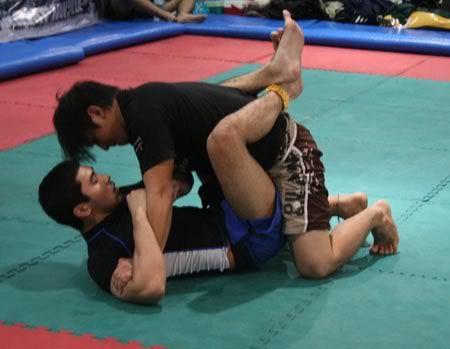 This is usually referred to as "top guard" or "bottom guard" for the guy on the top and the guy on the bottom respectively. This is considered a neutral position BJJ but isn't neutral in MMA because the guy on top can punch the guy on bottom. Generally speaking, the fighters want to do a few things here. The guy on bottom either wants to work his way back to his feet, or he wants to do what's called a "sweep". A sweep is when the position is reversed so that the guy on bottom ends up on top. The guy on the bottom can also submit his opponent from this position, but that is usually hard to do. The guy on top wants to "pass the guard", which means to move to a position that is better for the top guy. This brings us to the next position. 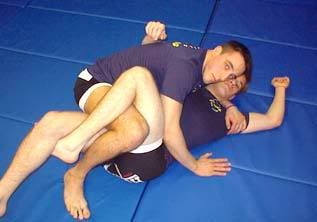 This is the half-guard. In the half the top fighter now has a better advantage. He is harder to submit and harder to sweep. He has almost passed the guard by working one leg free. He can also usually do more damage with punches because the guy on bottom has less control. 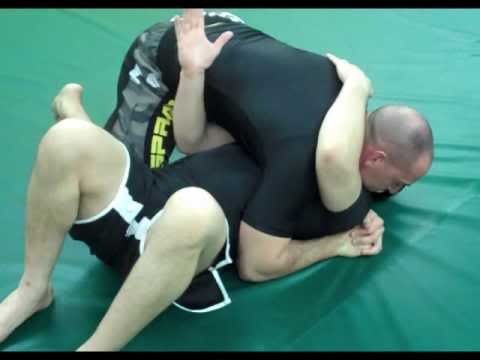 This is side control. The top fighter has now completely passed the guard. This is bad for the guy on bottom, he really wants to escape or return to guard. The guy on top can do a lot of damage from here, see GSP v. Serra II. The top guy can also hit some submissions from here. The guy on the bottom also has to be very careful to not let his opponent swing one leg over, which brings us to the next position.  This is mount. The top fighter can now throw down punches with a lot more intensity without worrying about getting caught in a submission. The fighter on the bottom is in huge trouble, a lot of fights end here. The fighter on top may also have opportunities for submissions.  Finally there is back control. One fighter is on the back of the other. See how the fighter on the back has his legs wrapped around his opponent? This prevents the fighter in front from turning into his opponent. These are called "hooks" and you'll often hear the announcers talking about someone as saying "he's taken the back, one hook is in, he's got the other one in!" That's because having the hooks in makes it much harder to escape back control. From here the fighter in front is very vulnerable to a submission called the "rear naked choke" or the "RNC" or sometimes the "mata leon". Those are the most common positions. There are 1,001 shades within these, and there are a couple positions that I'm not covering here (north and south, knee on belly) because those are usually transitory positions. Now let's look at the more common submissions. There are lots more than what I'm covering here. I'll also talk about the positions where these submissions are usually used, but a lot of them can be hit from all sorts of positions. Armbar 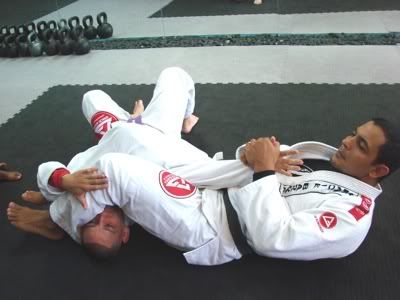 This is one of the most common submissions. The arm is extended straight out, and the goal of the submitter is to get his hips as close to his opponent's shoulder as possible. From there he is able to use the leverage of his hips to hyper extend the arm. This can be hit from all kinds of positions but is most commonly done from guard (below) and mount (above). Triangle 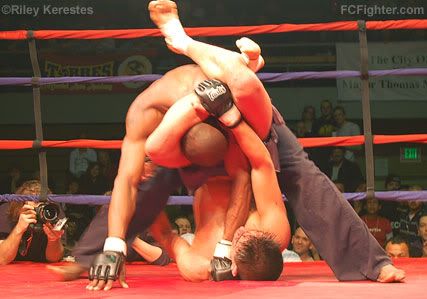 This is one of the most common chokes in MMA. It is usually performed from guard. It works by trapping an arm inside the guard. One leg is forced against the chokee's neck, the other forces the trapped arm to apply pressure to the opposite side of the neck. This, like almost every choke in MMA, is a blood choke. That means the goal is to cut off bloodflow through the neck to the brain. This is much, much faster than a choke on the airway and will put people out in about 15 to 30 seconds most of the time, sometimes faster. Generally people will tap out before they go out. Googling around looking for a picture for this submission lead me to this blog, where you can go to see the triangle in action. Guillotine 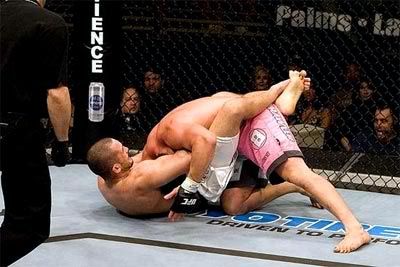 This is the one exception to the blood chokes rule. The guillotine can be done as both. This one is pretty simple. The aggressor catches the other person's head by wrapping their arm around their neck from above, then cranks on it. This is usually finished by "pulling guard", which means to jump up and wrap the legs around the person getting choked. This lets the choker get a lot more force on his cranking. This can work because it cuts off bloodflow, or because it cuts off airflow, or simply as a neck crank. This also fails quite often where people slip out. The guillotine is most commonly done from none of the positions above, but instead from when someone tries to take down their opponent and gets their neck grabbed for their trouble. Rear Naked Choke  Wrap one arm around their neck, with their throat centered on the elbow. Grab your own bicep on the opposite arm with the choking arm. Put the non choking arm on the back of their head. Win. This is done from the back position, and it is how most fights are won from that position. Done correctly, it is very very effective. For an idea of how little power this takes, see this video. Kimura (and its cousin, the Americana) 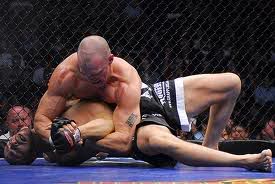 This is generally done from side control, but it can be done from mount and possibly from the guard. Try this. Take your arm and raise it so that your upper arm is parallel to your shoulders. Raise your forearm and hand so that your elbow has a 90 degree turn. Like this __| Where the two lines are your shoulder and upper arm, then the line pointing up is your forearm. Now, keeping the upper arm and shoulder in line with each other, try to move your hand backwards. Notice how fast you run out of range of motion? If you try to move it further, you can feel your shoulder and upper arm lock up. Keep moving and it gets painful. Now imagine there's some giant sweaty dude on top of you. He has locked your arm in place and has his arm under yours to raise it from the mat, while cranking your upper arm in the direction it doesn't want to go. This has a bunch of names depending on which direction the upper arm is pointing and which martial art you come from - keylock, americana, chicken wing, figure four, ude-garami or double wristlock. There's a cool story as to how it came to be called the Kimura in BJJ. Masahiko Kimura posted:"20,000 people came to see the bout including President of Brazil. Helio was 180cm and 80 kg. When I entered the stadium, I found a coffin. I asked what it was. I was told, "This is for Kimura. Helio brought this in." It was so funny that I almost burst into laughter. As I approached the ring, raw eggs were thrown at me. The gong rang. Helio grabbed me in both lapels, and attacked me with O-soto-gari and Kouchi-gari. But they did not move me at all. Now it's my turn. I blew him away up in the air by O-uchi-gari, Harai-goshi, Uchimata, Ippon-seoi. At about 10 minute mark, I threw him by O-soto-gari. I intended to cause a concussion. But since the mat was so soft that it did not have much impact on him. While continuing to throw him, I was thinking of a finishing method. I threw him by O-soto-gari again. As soon as Helio fell, I pinned him by Kuzure-kami-shiho-gatame. I held still for 2 or 3 minutes, and then tried to smother him by belly. Helio shook his head trying to breathe. He could not take it any longer, and tried to push up my body extending his left arm. That moment, I grabbed his left wrist with my right hand, and twisted up his arm. I applied Udegarami. I thought he would surrender immediately. But Helio would not tap the mat. I had no choice but keep on twisting the arm. The stadium became quiet. The bone of his arm was coming close to the breaking point. Finally, the sound of bone breaking echoed throughout the stadium. Helio still did not surrender. His left arm was already powerless. Under this rule, I had no choice but twist the arm again. There was plenty of time left. I twisted the left arm again. Another bone was broken. Helio still did not tap. When I tried to twist the arm once more, a white towel was thrown in. I won by TKO. My hand was raised high. Japanese Brazilians rushed into the ring and tossed me up in the air. On the other hand, Helio let his left arm hang and looked very sad withstanding the pain." Arm Triangle  This submission may pop up any time a fighter is mounted, and the fighter on top manages to isolate the arm of his opponent. I'm not great at explaining this stuff, so here's a diagram. 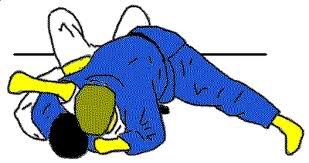 The fighter on top will then rotate his body away from his opponent, this puts a crazy amount of pressure on the fighter on the bottom. It applies the same principles as the triangle (isolated arm, blood choke) but uses the arms instead. You will sometimes here it called "turning the clock" when the fighter rotates to apply pressure. Those are all the common submissions. There are those that are less common but still happen - kneebars, heel hooks, ankle locks, omoplatas, gogoplatas as well as those that are nearly unique, like the Mir lock. Most subs you see will be one of these, or a variation on one of these. Warning: While I Do Train, I am still new to BJJ and I'm sure someone may take issue with some of the things I wrote here, they may not be 100% technically perfect but they should be pretty good. Grifter fucked around with this message at 19:27 on Feb 2, 2011 |
|
|
|

|
| # ¿ Apr 28, 2024 00:46 |
|
How much does it cost a bar to show a PPV?
|
|
|
|
henkman posted:Taxes. Five Cent Deposit posted:I know MMA in general and UFC specifically are sometimes shady (duh) but I hope they aren't as shady as the various boxing promoters out there... I just want to hear the thoughtfully reasoned explanation for the locker room bonuses. Especially since they aren't such closely guarded secrets. Off the top of my head, I can think of a list of reasons why the UFC would do this.
1st AD posted:I can't think of many industries where your coworkers actually know your salary (unless you tell them).
|
|
|
|
What kind of wacky round system were they using in the early PRIDEs? I was looking at Pride 2 on wikipedia and came across this. * Openweight bout: Brazil Royler Gracie vs. Japan Yuhi Sano Gracie defeated Sano by submission (armbar) at 33:14 of round 1. And this. * Middleweight bout: Brazil Renzo Gracie vs. Japan Sanae Kikuta Gracie defeated Kikuta by submission (guillotine choke) at 0:43 of round 6.
|
|
|
|
Can someone talk in depth about takedowns? Different types, how to tell a good one form a bad one, maybe some gifs of "here's a good one" vs. "here's a bad one".
|
|
|
|
I was really impressed by Aldo's head movement against Hominick. Even when the rest of him was dead tired, he was still able to use it to dodge a lot of Hominick's strikes. Why don't we see more of that? I'm not talking Aldo specifically, it's more that most MMA fighters are closer to Nick Diaz than Muhammed Ali in terms of head movement.
Grifter fucked around with this message at 01:15 on May 16, 2011 |
|
|
|
Teepkick Shakur posted:Are there pride DVD (or blu ray) box sets available that show the complete events as aired? I was going to purchase the ones distributed by the UFC but apparently they dont show any of the walkouts and cut out any camera shots of the commentators.
|
|
|
|
Tezcatlipoca posted:I know I just think it's interesting that it doesn't really matter how much power is behind the punch if it isn't accurate and well timed.  Walking backwards while throwing what looks like a zero effort punch, but it clearly catches Forrest perfectly and rattles his brain - look at how his head snaps around.
|
|
|
|
I think the statement can be read in a number of ways but for whatever it's worth I agree that JJ could be fairly described as someone with the most raw talent upon entering MMA. He wasn't described as having achieved the most or as the most experienced, but with the largest base talent.Xguard86 posted:well its a flawed analogy because college football is so high profile that potential #1 draft choices (IE: the Army All American Game) are predicted even when they are still in High School. In a theoretical MMA world were amateur fights receive that kind of scrutiny, Bones would be a top pick. Someone like Brock Lesnar or Bj Penn would also be a #1, but you wouldn't take say Edgar or a young GSP and say they're going to be hall of famers.
|
|
|
|
Xguard86 posted:You can read a little about how it started, its all actually pretty interesting, if you flip through a copy of The Blind Side.
|
|
|
|
I've seen a number of people say that Chael is no longer training with Team Quest Gresham. Who is he with now and when did he make the transition?
|
|
|
|
On the other hand, I think he's gained a bit more sympathy now that we know he was bullied by Matt Hughes and is generally down on himself.
|
|
|
|
Avenging_Mikon posted:Ah, something I'll notice after watching more fights, I suppose. I thought the way "lay and pray" is brought up, it might have been a thing that actually happened more than almost never. (Good fighters usually don't try that many subs from the bottom anyway, they're too busy using their hooks to initiate a scramble and escape back to their feet. See Edgar, Frankie.)
|
|
|
|
It looks like at least in Nevada caffeine is most likely not banned but it's a bit confusing. They have a blanket ban on all stimulants, but they also say that they use the WADA list (anything on that list is banned by NSAC), and WADA specifically defines caffeine as fine in competition.quote:The following substances included in the 2012 Monitoring Program (bupropion, caffeine, nicotine, phenylephrine, phenylpropanolamine, pipradol, synephrine) are not considered as Prohibited Substances.
|
|
|
|
heeebrew posted:Any documentaries or perhaps books that could explain the history and evolution of martial arts throughout the world or perhaps throughout Asia or something? Any good martial arts documentaries period? For more current stuff there's a documentary about Anderson Silva called Like Water which has been well reviewed but as far as I know hasn't been distributed so it would be hard to find. There's a documentary about Jon Fitch called Such Great Heights but I'm also not sure if that one can be easily found either. I haven' seen Jens Pulver's documentary but if it's anything like Jens Pulver it's probably horribly depressing. I'd be curious if anyone else has suggestions on books. I've read Matt Hughes's autobiography (Made In America) and while it's interesting as a portrait of sociopathy I don't know if I'd recommend it as a book. I've also read Forrest Griffin's book (Got Fight) which is funny but doesn't really tell you that much about MMA.
|
|
|
|
Save Russian Jews posted:I was thinking it could just be a general MMAth thread, like a repository for crazy stat-poo poo (I'd honestly love to have whatever access dokmo has to fight info) and those sometimes-cool, sometimes-not who-beat-who flowcharts.
|
|
|
|
Save Russian Jews posted:I'd like to take a look at it, at least. Sorry for falling off the face of the earth, my school does half-semesters so right now I'm in the middle of midterms week. Polemides posted:Having never seen this Shannon Ritch guy fight, and based solely on his ridiculous record, I like to think he comes out like a froth mouthed berzerker from the opening bell Grifter fucked around with this message at 00:31 on Feb 15, 2012 |
|
|
|
Bubba Smith posted:5) I believe Lesnar had his heart into his training, just not his heart into fighting. After the past two years with all of his medical problems, he likely decided that he doesn't need to risk it when he has a family to take care of. As of now he can earn about the same amount of money doing WWE that he did doing MMA, except he doesn't have to push himself nearly as hard.
|
|
|
|
heeebrew posted:Does Freddie Roach suffer from some form of dementia? I apologize if this is an offensive question but something seems off about his speech/head movements.
|
|
|
|
This is from the b-league thread but it's a historical question about MMA so I am posting it here.-Atom- posted:Public voting worked out really well when the UFC let people decide on the Fight of the Night
|
|
|
|
ROFLburger posted:Holy poo poo
|
|
|
|
NovemberMike posted:Yeah, one of the issues with chin talk is that we're seeing the fights and not feeling them from the fighters perspective. A lot of stuff that can look impressive to us might have someone rolling with the punch and not being hit that hard while hits that look weak can hit flush on someone that isn't prepared. The whole "chin" conversation blends a ton of stuff that shouldn't be combined if you're trying to have a realistic conversation.  It looks like barely a tap.
|
|
|
|
Halloween Jack posted:I remember when he was given Sinosic, who was 1-5 in the UFC and basically came back just to lose to Bisping and wash out. Then after the Hamill and Evans fights showed he wasn't ready for prime time, he was given McCarthy, who also came back from the indies just to lose a retirement fight to Bisping. Then when the Henderson demonstrated that he still hadn't stepped up to the next level, he got Denis Kang. After loving up the chance to look great by beating an over-the-hill Wanderlei, he got the guy who lost to both of the prominent middleweight contenders. In retrospect, he did eventually step up, but back in 08-09 it really felt like he was being bottle-fed until he was strong enough, and he easily could have washed out without the benefit of some clever booking.
|
|
|
|
EvanSchenck posted:We mostly do monthly UFC threads about current events and then sporadically people try to do special threads about interesting topics that slip through the cracks. Just throw poo poo in the monthly thread, people are always down to get a fresh fan addicted.
|
|
|
|
Has Matt Brown actually improved in his sub defense? I recently rewatched the Brown/E. Silva fight and I have to believe that the Brown who got subbed by Seth Baczynski would have gotten RNC'd by Silva during the early part of the first round.
|
|
|
|
Bundt Cake posted:Bascynzki is actually a pretty good fighter and was easily hurting matt standing, and hurt him bad before he guillotined him. As far as improved sub defense, I guess if hes drilled way more and could instinctively defend the choke better yeah then he wouldn't get choked. But pretty much anybody is vulnerable to being choked when theyre unable to avoid getting hurt on the feet and are forced to go to an area of the fight where they aren't as comfortable.
|
|
|
|
I was looking at Oleksiy Oliynik's record this morning and saw that he RNC'd Monson in Oplot. Was this one of those cases where someone gets stunned or knocked down, then subbed while their brain is still jangling, or did Oliynik really outgrapple Monson?
|
|
|
|
Is Hendricks still with Team Takedown? I'm wondering if that whole effort might have paid for itself pretty much solely through him.
|
|
|
|
It's the clock that makes this. My brains wants to believe it's a 1/2 second loop but noooope.
|
|
|
|
When I think accuracy, I think Anderson.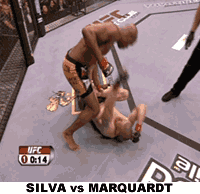 He waits for the right moment and then just goes straight through the guard and hits on the button.
|
|
|
|
New forum name is excellent.
|
|
|
|
Elemennop posted:This is basically a meaningless statement and applies to all grappling. Imagine what a style of grappling that doesn't use the opponents weight against them would look like. Just deadlifting your opponents?
|
|
|
|
I.N.R.I posted:i should think it depends on how many concussions you get while doing them I think the answer to the question is it depends on the person but none of them are good for your brain.
|
|
|
|
Tezcatlipoca posted:A fighter who relies heavily on their attributes to win. Renan Barao and Brock Lesnar are attribute fighters. Cody McKenzie is the opposite of an attribute fighter.
|
|
|
|
Neon Belly posted:You're starting to sound like Joe Rogan now CommonShore posted:The difference is that an attribute fighter builds the style and success around that specific physical attribute. Jon Fitch and Rick Story are extreme examples of fighters who don't have many noteworthy attributes. Even Robbie Lawler and Rory MacDonald don't have any physical characteristic that seems intrinsic to how they approach fighting. quote:You're right in that it's not a binary thing. Fighters can be more or less dependent on their attributes, but "in good shape" isn't a noteworthy attribute for a pro fighter. I.N.R.I posted:even if it was true the fighters who have the best bodies are the hardest workers anyway. like yoel romero and souza etc.
|
|
|
|

|
| # ¿ Apr 28, 2024 00:46 |
|
I am sad that Nam Phan was pretty crappy. He is a cool dude.
|
|
|





